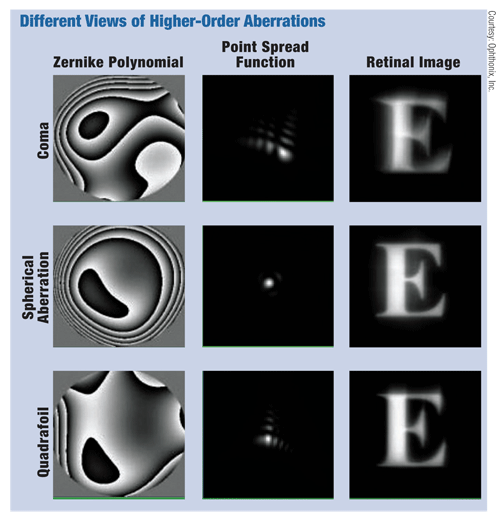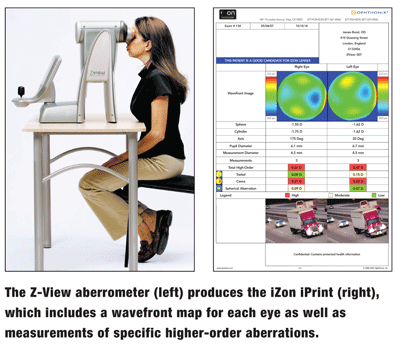 When wavefront-based excimer laser surgery first became available a few years ago, surgeons debated which patients should undergo conventional or wavefront-guided surgery. Now, due to better visual outcomes, the prevailing notion among leading refractive surgeons is to perform wavefront-guided surgery whenever patients qualify for it.
When wavefront-based excimer laser surgery first became available a few years ago, surgeons debated which patients should undergo conventional or wavefront-guided surgery. Now, due to better visual outcomes, the prevailing notion among leading refractive surgeons is to perform wavefront-guided surgery whenever patients qualify for it.
Despite the success of corneal refractive surgery, there are some drawbacks to these procedures: inability to pattern periodic changes in higher-order aberrations over time, variability in the outcome due to corneal healing and biomechanical changes, a small but measurable risk of permanent loss of best spectacle-corrected visual acuity, and greater cost.
Fortunately, there are non-surgical treatments for reducing higher-order aberrations. Indeed, there is the intriguing possibility that wavefront-guided glasses and contacts might supplant conventional glasses and contacts in the same way that wavefront-guided LASIK has superseded conventional LASIK. This article spotlights wavefront-guided ophthalmic lenses.

The Importance of Higher-Order Aberrations
Traditional objective refraction measures sphere, cylinder and axis but ignores higher-order imperfections, such as coma, spherical aberration and quadrafoil. (See Different Views of Higher-Order Aberrations.) The detrimental effects of higher-order aberrations on vision are not adequately compensated for with conventional lower-order spectacles. Optimal visual performance requires the simultaneous compensation of both lower and higher-order aberrations.
For the average person, higher-order aberrations represent approximately 17% to 20% of the total refractive error.1 Of course, the percentage varies depending on the total magnitude of ametropia. Higher-order aberrations often are the primary culprit among patients complaining of poor overall visual quality, even with updated conventional glasses. These patients may describe fuzziness around images, halos and comets from lights at night, and lack of overall clarity of vision, even if they can discern the 20/20 letters on the Snellen chart.
As many as 96% of myopic patients and 77% of emmetropic patients have higher-order aberrations of 0.1mm or greater (root mean square at 4.5mm pupil diameter), according to Ophthonix Inc. At 0.1mm, patients vision could be affected to the degree that they could benefit from wavefront correction. So, the presence of higher-order aberrations in the population is significant and presents an opportunity for the clinician to measure and correct. The correction of higher-order aberrations may even benefit certain non-presbyopic emmetropesa previously untapped market.
Wavefront-Guided Spectacles
In 2005, Ophthonix, Inc. introduced non-surgical, wavefront-guided spectacle lenses with the customized iZon high-resolution single-vision lens. The customized iZon progressive addition lens was introduced in 2006. Both the iZon single vision and progressive lenses are driven by the patients optical fingerprint, or iPrint, measured by Ophthonixs Z-View wavefront aberrometer, which captures more than 13,000 points of resolution across a 7mm pupil. The iPrint is composed of the patients second- to sixth-order Zernike measurements.

One limitation of wavefront-guided eyeglasses is that a spectacle lens that corrects the full amount of higher-order aberrations would have a small viewing area. Higher-order correction would have to move with the eye and maintain perfect registration. A spectacle lens with a highly restrictive straight-ahead-only viewing area is not practical.
However, the iZon lens utilizes a unique algorithm that is applied to a patients iPrint to determine the best spherocylindrical back lens surface. This optimized back surface allows patients to shift their gaze, as they do not need to maintain perfect registration. Most iZon single-vision lens wearers do not notice a change in vision when viewing in the usual fields of gaze, according to Ophthonix. Even when patients look peripherally, their vision should be better than if they were to view through the corresponding area of a conventional spectacle lens.
The iZon lenses consist of a three-level multi-layer design: a front layer of 1.6 high index plastic; a center layer made of a photopolymer; and a back layer, also of 1.6 high-index plastic. The front layer of the lens does not contribute significantly to the total refractive lens correction. The back surface of the back layer is optimized (sphere, cylinder, axis) based on wavefront measurements, and for its progressive lenses, it includes the add power. The central photopolymer layer, known as iZonik, is UV-processed to change its refractive index. As part of the total multi-layer design, it contributes to the reduction of chromatic aberration of the lens.
Ophthonix custom manufactures each lens pair using the patients unique iPrint wavefront refraction. The optimized surface data, which include the higher-order aberrations of the eye, are transferred to manufacturing equipment at the companys laboratory, which incorpo- rates these into the iZon lens. The end result is a customized wavefront-guided lens designed exclusively for each patient. Ophthonix calls the result high-definition vision.
The iZon progressive lens also uses free-form technology to create the wavefront-derived sphere, cylinder and axis. This high degree of surface accuracy enables the designers to precisely control lens powers better than traditional lens surfacing and to generate designs that, up to this point, were not possible.
While the iZon lens is based on the higher-order aberrations of each patients eyes, several other new lenses employ wavefront technology to address the aberrations common in progressive lenses. Among these lenses are the Essilor Varilux Physio and Physio 360 lenses, and the Zeiss GT2.
Varilux Physio. Even the best progressive eyeglass lenses distort light waves as they pass through the peripheral optics of these lenses, reducing visual quality. The Varilux Physio and Physio 360 are progressive designs that minimize many of these distortions in the lens, particularly coma, by applying a technology known as Wavefront Advanced Vision Enhancement (WAVE) to identify and compensate for aberration deformities by controlling the quality of the wavefront that passes through the eyeglass lens. The result, according to Essilor, is a progressive lens with enhanced central and peripheral vision, a 30% wider corridor, greater coma control, and more contrast and greater acuity in all fields of vision. The Varilux Physio was introduced in 2006 and has become one of Essilors flagship lenses.
Zeiss GT2. This lens design is based on a system that the company calls Zeiss Optical Optimization and Management (ZOOM). This system controls the wavefront aberrations throughout the lens by carefully managing the progression of power and astigmatism.
Zeiss also introduced a new instrument, the Eye-Terminal, which employs a precision digital camera and computerized measuring system to photograph patients wearing their chosen frames. The instrument automatically measures monocular interpupillary distances, fitting heights, pantoscopic angle, vertex distance and frame wrap, all to an accuracy of 0.1mm. These measurements allow freeform surfacing to create advanced customized progressive lenses, including those that minimize inherent lens wavefront aberrations.
Technology such as Eye-Terminal can assist in the precise fitting of new lens designs influenced by wavefront technology in which lens positioning is crucial for optimal vision.
Future wavefront spectacles might be introduced by Pixel Optics, a start-up company in
This technology is under development and is not yet commercially available. It may become a future platform for correcting higher-order aberrations as well.
Clinical Data
In clinical investigations, the Ophthonix iZon lens yielded a significant level of patient preference compared with a conventional lens.2-5 For instance, when tested in an FDA-validated night driving simulator at 55mph, patients exhibited better than a 20-foot shorter stopping distance compared to conventional lenses.2 This clinical study showed that iZon lens wearers had a directional improvement on 12 tested hazard conditions, with seven being statistically significant.
Also, iZon lenses, when compared with traditional lenses, were preferred by patients with age-related macular degeneration. In these patients, the iZon lens demonstrated a trend of improved distance vision performance in low contrast conditions and exhibited a statistically significant improvement in reading speed of 20%.3
In addition to improved nighttime driving vision, patients wearing the iZon lens report generally sharp vision, improved contrast acuity and improved depth perception. Ophthonix claims that by also reducing chromatic aberration, the iZon lens enables patients to see colors with greater richness.5
Likewise, the Essilor Varilux Physio also was reported to provide better vision than standard progressive lens designs in all fields of vision.6 Additionally, worldwide studies with more than 2,000 patients conducted by Essilor show that wearers preferred Varilux Physio no matter what the ametropia, presbyopic age or previous type of lens worn.
Similarly, in a recent market study of the Zeiss GT2 lens, patients from seven different practices were fitted with two pairs of progressive lenses: one pair with the Zeiss GT2 and one pair with the eye-care professionals progressive lens of choice. Average score for overall wearer satisfaction was 8.7 out of 10 with the GT2 lens vs. 7.8 with the standard progressive lens. Further, the average score for straight-ahead vision was 9 out of 10 with GT2.7
A Bright Future for Wavefront
Typically, doctors first offer the least invasive but most effective treatment before the more invasive but less effective ones. This certainly has not been the case with wavefront-based treatment. Instead, refractive surgeons quickly embraced this advanced optical technology for laser vision correction, which, although effective, is the most invasive refractive treatment.
Now, eye-care professionals can offer wavefront-based technology for non-surgical refractive treatment. The reality is that a much larger number of patients would first consider non-surgical vision correction. As a result, non-surgical wavefront-based correction will probably drive optometric care for many decades to come.
Although the expansion of optometric scope of care may have drifted our profession away from the traditional roots of physiological optics and toward treating and managing ocular disease, non-surgical wavefront correction holds the promise of making refractive error an appealing and central part of our profession once again. Most importantly, our patients will benefit from better visual quality with the least invasive solution.
Dr. Chou is in group practice at
1.
2. Kensick J, Brown MC, Ginsburg A, et al. Improvement of night driving visibility detection with wavefront guided spectacle lenses: 2781/B964. Poster presented at annual meeting of the Association for Research in Vision and Ophthalmology; May 6-10, 2007;
3. Szlyk J, Seipel W, Parikh M, et al. Improvement of vision with wavefront guided spectacle lenses for patients with AMD. Poster presented at American
4. Binder PS, Dreher A. Visual acuity and contrast sensitivity in patients using wavefront customized spectacles. Paper presented at American
5. Patient ratings of iZon lenses. Ophthonix marketing research. Data on file.
6. McDonald MB and the Essilor Study Group: Wavefront technology improves vision by reducing aberrations in progressive lenses: PO209. Paper presented at American
7. Patient marketing trial. Data on file with Carl Zeiss Vision.

